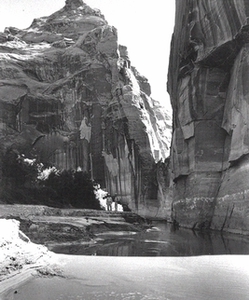SAN JUAN COUNTY

Glen Canyon of the Colorado River, 1956
Area: 7,725 square miles;
Population: 12,621 (1990);
County seat: Monticello;
Origin of county name: after the San Juan River;
Principal cities/towns: Blanding (3,162), Monticello (1,806), Bluff (250);
Economy: livestock, agriculture, mining, tourism;
Points of interest: Natural Bridges, Rainbow Bridge, and Hovenweep national monuments, Lake Powell, Glen Canyon National Recreation Area, Canyonlands National Park, Edge of the Cedars State Park in Blanding, St. Christopher's Episcopal Indian Mission in Bluff, Navajo Indian Reservation.
San Juan County is a part of the Colorado Plateau, a geologic region formed mostly of sandstone and limestone that includes two-thirds of the state of Utah as well as parts of Colorado, New Mexico, and Arizona. Mighty rivers like the Colorado and the San Juan have carved deep canyons and unusual erosional forms through the colorful sedimentary rock, and many people find the area to be spectacularly beautiful on a grand scale.
In prehistoric times, the San Juan country was the home of the Anasazi, whose cliff houses, pictographs, and petroglyphs have baffled and fascinated visitors to the country since their disappearance shortly after A.D. 1300. The Basketmakers, the earliest phase of the Anasazi Culture, were first identified and studied in Grand Gulch. The Navajo Indians, who were perhaps a cause of the disappearance of the Anasazi, now occupy a large part of San Juan County--from the San Juan River to the Arizona border.
Although there were a few white residents along the San Juan River before 1879, the Mormon scouts who planned the famous Hole-in-the-Rock Trail that year began the full-scale settlement of San Juan County. The 230 pioneers who left Escalante in the fall of that year arrived at the present site of Bluff on 6 April 1880.
Farming along the San Juan River bottom was a chancy proposition, for the treacherous river either flooded or went dry too often for dependable irrigation. Early cattleman like the brothers Al and Jim Scorup did better in the rough canyon country than did farmers. After a decade of fighting the elements, many settlers discovered that life was somewhat easier in the high country around the Abajo Mountains, and the towns of Blanding and Monticello replaced Bluff as the main focal points of San Juan County life.
Mining has been an inconsistent but exciting part of the economy of the county. A gold rush on the San Juan River in the early 1890s was short-lived, but miners in Glen Canyon of the Colorado River eked out a better living from deposits along the river bars. Oil and gas exploration around the turn of the century was productive, and one can still see wells operating along the San Juan River. The uranium boom of the early 1950s, however, brought large numbers of people into the area and saw the creation of a few large fortunes.
At present, most residents see tourism as their most promising economic resource, particularly since the creation of Lake Powell in the early 1960s. Rainbow Bridge is the most popular tourist attraction in the county, but the marinas at Hite, Hall's Crossing, and Piute Farms draw large numbers of visitors, and river trips through Cataract Canyon and on the San Juan River are also popular.
Disclaimer: Information on this site was converted from a hard cover book published by University of Utah Press in 1994. Any errors should be directed towards the University of Utah Press.